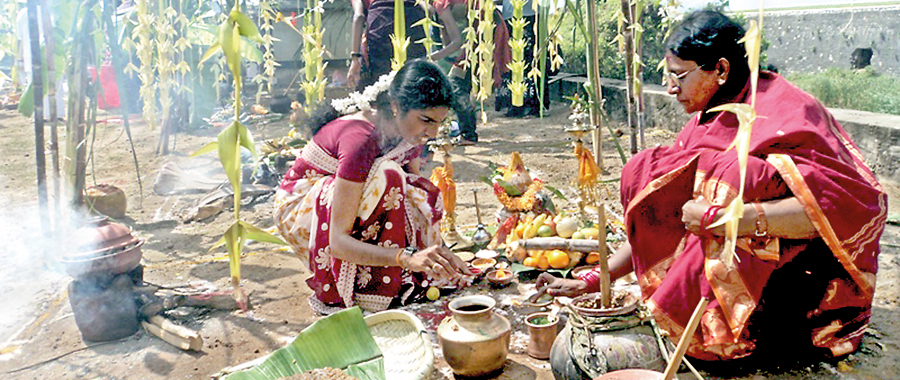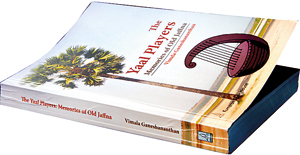Cleaning, cooking and decorating: It’s Pongal in our village
View(s):In her recently released book ‘The Yaal Players- Memories of Old Jaffna’, Dr. Vimala Ganeshananthan draws on her mother Emily Gnanam’s writings, found jotted down in her beautiful flowing hand in school exercise books to recreate life in Jaffna during the early 20th century. We publish here an extract from the book which relates how the family celebrated the festival of Thai Pongal in their village.
Thai Pongal falls tom0rrow
The dawn of the year in our village was not the first of January but most often the fourteenth of that month. January first was celebrated only by the Christians- just a few of us, in our village. The fourteenth, sometimes a day earlier or later, marked on the Hindu almanac, was the calculated date in which the sun moved into the Phase of Capricorn, astrologically a pre-Galileo concept of the sun moving and not the planets.

The women of the household prepare for Pongal (file pic)
The sun’s entry into Capricorn meant that it would travel north and back to its zenith. The warm rays of the sun ensured the ripening of the paddy and ensuring what was wished for, a plentiful harvest. This auspicious day was Thai Pongal, pongal literally meant the boiling over of milk and considered the first day of the New Year. The calendar at home marked the western dates with the Hindu dates below it. The calendar also had the day divided into auspicious hours which was taken great note of for auspicious events. The next day, the Maatu Pongal, the cattle pongal was done as a thanksgiving to the cattle that played an indispensable role in an agrarian society.
Pongal was a thanksgiving of the previous year’s harvest and the harvest to be. Like in most festivals, it meant a thorough cleaning of the house. The evening before the Pongal, the females of each household squatted on their haunches and mopped the floors with water in which a generous amount of saffron had been dissolved. Pongal was prepared in the open in the front of the house, early the next morning, prior to the rising of the sun, whose first rays we hoped would see the boiling over of milk.
Grandfather made the biggest Pongal and every member of the family would partake of it. The younger families too made it in their homes. Widowed members did it in their kitchens. There was so much to be done before the actual cooking of rice. Mango leaves were strung on top and across the front door. The boiling of the milk was done in the garden in front of it. Like in all festivals and sometimes on auspicious days too a decoration, the kolam, was drawn on the cemented front verandah and in front of the fireplace to be.
A married female, bathed and dressed in a colourful sari, drew a square on the ground in front of the house with rice flour, drew another decorative kolam within it and arranged a fireplace facing east. Like on any other auspicious event, there would be the ceremonial brass pot of brimming water and its ccompaniments of a coconut and mango leaves. The pot was placed on a banana leaf strewn with rice. A lamp with five lighted wicks was on one side of it. A new large clay pot had been purchased, and cleaned and washed mango leaves tied round its neck with a few stems of sugar cane among them.
It was filled with sufficient milk to boil over, placed on the fireplace and the fire was lit with wood chippings and camphor. It seemed as if it took ages for the milk to boil over and it became the proverbial ‘watched pot.’ The boiling over of milk was anticipated mostly by the children. It was believed a good omen if the milk boiled over the rim that faced the east. There was a little cheating with the pot tilted a little to east prior to the boiling. This was overlooked as being on the safe side. Finally the milk boiled over accompanied with loud vocal salutations to the sun that came over the east, and louder prayers for a good harvest expected in a couple of months. All these vocalizations were drowned by the noise of firecrackers and the general melee of noisy joy.
Grandfather would bring a few measures of rice which had been cleaned and kept with care from the last harvest. He put in a handful or three hands full, as numbers should be of the odds, into the pot of milk. The ritual was followed by other married members of the family. The milk in excess, of that needed for cooking the rice, was removed from the pot.

There seemed to be much more to do to make the rice palatable and sweet. Green gram was added, and when the rice and the green gram were cooked, palmyrah jaggery, raisins, amd split cadjunuts were added to the pot. Usually a senior aunt would take charge of the final cooking with much bossing.
Finally it was announced that it was ready. The head end of banana leaves and smaller rectangles cut from other banana leaves came in thick and fast. Three ladles full of the Pongal were placed on the large banana leaf and placed on the ground. Circulambulation of this with prayers was done by the Hindu relatives. All of us had a small portion of the sweet milk rice with the added sweetmeats and savouries to complete the meal. The older members of my family did not partake of this as it was thought to be a Hindu ritual and we were now Christians.
Grandfather would query as to why we did not celebrate the harvest in like manner and thank our God in similar fashion. My older sister having an answer to every query, would explain why not to our grandfather. She explained to him, in what seemed to me long sentences, that the missionaries who brought Christianity to us, brought Christianity with certain of their more cultural Western customs included in it.
She was proud to say that we had a harvest festival offering fruits and flowers in our church in the month of October. He was amused and amazed that we celebrated harvest in the month of torrential monsoonal rains and remarked that it could not possibly be a thanksgiving for any crop. For every query my sister had a ready answer. Her final repartee was to tell him that Christianity and its missionaries made a dent in the caste system by educating all castes. She added that all castes were equal on the playing field and the social events of a Christian school. She reminded grandfather that he had not even improved the status of his household castes.
The Roman Catholics were more progressive and amenable to introduce cultural backgrounds into their faith. Pongal, on its day, was made at the entrance of their church. The ceremonial brass pot of water, its additions and the lighted brass lamps were kept there too. The cooking of the rice was followed by a thanksgiving mass in the church. They introduced more cultural accompaniments in the wedding ceremony too, including the loud natheeswaram, the local classical music.
Years later, we regretted that the Protestant missionaries failed to introduce Christianity within the cultural environment. They could have won more souls doing this.
Pongal was always followed by many in our family attending the local temple for the pooja of thanksgiving which was accompanied by music, especially of the deep bass thavil drum and the local clarinets. This type of music was always a part of temple worship. Invariably a devotee got into a religious frenzied dance. The devotee in this state was said to prophesy and declare oracles. The truth was never verified. The frenzied dance would be stopped by sprinkling or even pouring water on the frenzied dancer.
Pongal was still not over. The cattle were honoured the following day. They had been allowed to range freely the previous day. The cattle shed was cleaned thoroughly, the hearth prepared near it and the milk rice, jaggery in plenty and more green gram was cooked ceremoniously. The cattle was washed, the bulls’ horns were coloured with crayons, garlands of hibiscus flowers and bells strung round their necks and holy ash applied on their foreheads.
A prayer for the gift of cattle was said. The cooked rice was placed on banana leaves with other fodder, plaintains and fed to the cattle. The cattle were not worked for a couple of days. Grandfather and the women folk who milked the cows would make much of them, stroking them and embracing their calves. The local cattle were brown and much smaller than the bigger white Sindh cattle brought from India. A cow was never sent for slaughter, however old. The bull would be taken away after it had ceased to be a stud or could no longer be worked by the household.
The Yaal Players is available at Rs. 1,200 at Vijitha Yapa and Barefoot Bookshops and also can be ordered online on amazon.com
Follow @timesonlinelk
comments powered by Disqus


















